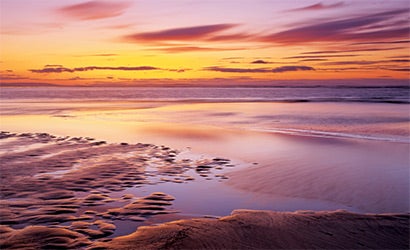A Day at the Beach
Going to the shore this summer? Here's your hour-by-hour guide to getting the best pictures ever.

You returned from last August’s vacation at the shore with only sand in your swimsuit? This year, come home with fantastic pictures. A day at the beach — from sunrise to sunset — can present a sea of photo opportunities. To stoke your creative engines, here’s a day-long breakdown of the shots that await, plus tips for making the most of the often challenging conditions. Your goal? The best vacation album ever!
5:30 A.M. SUNRISE
Sunrises over water can be spectacular. Pick a day, steel your resolve, and drag yourself from bed before dawn. On the West Coast? Lucky you! You get to shoot sunsets instead, although the sun as it comes up over the land can light shore elements along the Pacific in ways that reward the early riser. On either coast, weather reports will alert you to favorable clear-to-partly-cloudy sunrise conditions. If heavy cloud cover is predicted, better pass.
Watch out for tilted horizon lines — they usually look best leveled. For super-saturated reds and oranges, and to make clouds pop voluminously, try the Moose Peterson Warm Polarizer from Hoya (from $40, street). Two filters in one (a warmer and a polarizer), it can make a sunrise explode with color.
Depending on the angle of the light, polarizers may or may not have a galvanizing effect on a seascape. To recognize scenes that can benefit from a polarizing filter, wear polarizing sunglasses.
When it comes to sunrises, always be sure to bracket your exposures like crazy from way under- to way overexposed.
6:30 A.M. EARLY MORNING
Once the sun is up, it’s time for solitary beach combing. Early morning sun strafes surf and dunes at low angles, dramatically defining sand patterns and throwing sensuous shadows behind dunes, dune grass, and snow fences. This may be your only chance for seascapes free of people. Find photos in driftwood, shells, and other gems that have washed ashore over night. Get them before other beachcombers disturb or snap them up.
Close-up filter sets or a macro lens will give you the magnifying power to capture the exquisite detail in shells, scurrying sand crabs, and colorful tidal pools.
9:30 A.M.
When the kids hit the beach, it’s time for candid sand and surf shots. Because it can be hard to control the exuberance, it’s best to use waterproof or even single-use cameras. Budget two mornings for surfside candids, one sunny, the other overcast. Sun is good for active shots — challenge your kids to splash-filled races through the waves. Clouds are for intimate portraits, shot close at a wide aperture to minimize cluttered backgrounds.
When buying single-use cameras, spring for those with built-in flash, and use the flash for almost every shot to open up the dark shadows that contrasty beach lighting is famous for.
For effective fill flash, keep subject distances to between 3 and 5 feet. Any closer, and Aunt Susan will be out of focus; any further, and the flash will have minimal effect.
You also can control contrast through bracketing exposures and through composition. Put 85 percent of your subject (including important elements) in either shadow or direct sun, then spotmeter, and contrast won’t pose such a problem.
Direct sun is perfect for in-surf portraits taken with waterproof digital compacts such as the Olympus Stylus 770 SW ($330, street) or the Pentax Optio W30 ($263, street; see The Goods in this issue). A single-use film camera such as Kodak’s MAX Water & Sport ($9, street) will work, too. Keep the sun behind your subjects to produce the backlighting that often creates sparkling highlights in moving water. Don’t forget the fill flash!
For intensely colorful candids, outfit your crew with swim trunks, towels, T-shirts, and toys in bold primary colors. Avoid weak pastels, distracting text, patterns, or designs. (The exception? A white or off-white umbrella can double as a diffuser or reflector). Finally, if shooting digital, crank up the saturation.
NOON-2:00 P.M.
Sunlight from directly overhead spells trouble, so take a break. Besides, it’s time for lunch!
3:00 P.M. THE B-ROLL
As energy flags at water’s edge, it’s time for overviews and details to fill out your vacation album. Film makers call it “B-roll” material: It might include close-ups and exterior shots of your vacation home, fun haunts (such as diners and boardwalk attractions), and beach-town signs. Seek out local color, human interest, and humor. Colorful souvenirs and surf-shop wares will seem surprisingly exotic in snowy February.
As your afternoon winds down, swing back to the beach for shots of exhausted vacationers as they quietly read, sunbathe, or sleep.
5:30 P.M. TO SUNSET
Now’s the time for a semi-posed group portrait on the beach. Gather your family or friends before simple backlit dune grass or a jetty. (For more on formal beach portraiture, see “Four Perfect Moments,” April 2007.) Pick a day that’s not too windy, have a tripod on hand, and select clothing with coordinating colors and no loud prints.
Try the classic compositions: Arrange the crew so that an imaginary line drawn from face to face would form a triangle (for three or six people) or a diamond (for four). Use the setting sun as a backlight, etching golden outlines around their heads and shoulders. Spotmeter off a face for exposure, use the tripod if necessary, and pop a flash to fill in the shadows.
Finally, after the formal portraits are over, keep your camera ready and accessible. Candids of the clan quietly wending its way homeward through the dunes can make the perfect close to a photo-rich day at the beach.